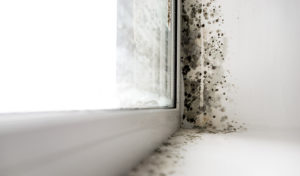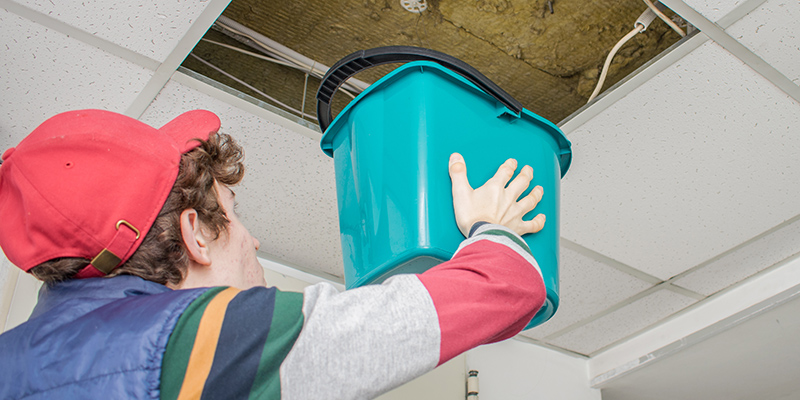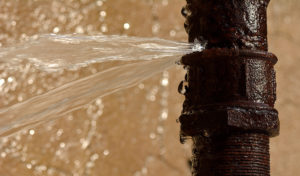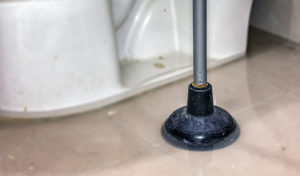Commercial building water damage can be costly and tedious to repair. The best way to avoid this problem is to know what causes it and how you can prevent it.
Most Common Causes of Commercial Building Water Damage
Water damage is a chief concern of commercial property owners. Because it can go unnoticed for many years, water damage can be a silent menace. As such, it is imperative to know how water damage occurs to keep it at bay.
Here are the most common causes of commercial building water damage.
1. Damaged Pipes
When a commercial building has damaged pipes, water damage is almost a guarantee. Damaged pipes can result from pressure changes, freezing temperatures, and declining water supply lines. And the damage can cause water to seep out and into the walls. Some telltale signs of broken pipes include loose tiles, water stains on walls or floors, swollen walls, and a moldy smell.
 2. Damaged Windows
2. Damaged Windows
Believe it or not, windows can directly cause commercial building water damage. This usually happens when you have broken windows or windows that are not sealed properly. When there are gaps or holes in the windows, moisture can creep in and cause water damage as well as mold growth. Therefore, it is important to make sure all your windows are sealed correctly. Recaulking may be necessary, as caulk can deteriorate with time.
3. Leaky Roofs
When your roof is damaged, it can cause water to leak inside. This, in turn, will lead to mold growth, ceiling damage, and shortened wires. It can even affect the structural integrity of the entire building, especially if the water does not drain properly through the gutters and finds its way inside the building’s foundation.
While roofs are made with durable materials, they can decay over time. Snow, ice, and heavy rain are known culprits of roof damage. To keep your roof in good shape, make sure to remove snow and ice as soon as possible and repair damages immediately. You should also unclog and clean your gutters regularly.
4. HVAC Issues
There are many things that can go wrong with your HVAC system — from frozen pipes and evaporator coils to clogged drains and general wear and tear. All of these can lead to water damage. You should also check your HVAC ducts every now and then. These ducts are responsible for the travel of air through the building, but worn ducts can start to leak. Additionally, it is critical to have your HVAC system cleaned regularly.
5. Plumbing Problems
Plumbing issues are another common cause of water damage. Tall buildings, in particular, experience a lot of toilet problems because of the stacked plumbing. To prevent this, you should inspect the hoses regularly. If there is any damage, have them repaired or replaced. It is also a good practice to replace all of the hoses every 3 to 5 years regardless of their condition.
6. Sprinkler Leaks
Sprinkler systems are a must when it comes to fire safety in commercial buildings. But, sprinklers can also cause water damage if not properly cared for. It is important to inspect and maintain your sprinkler system regularly. You should also watch out for any signs of sprinkler leaks such as mold and mildew, wet drywall, soaked carpets, and standing water.
7. Boiler and Machinery Issues
If your commercial building has multiple boilers, you are more prone to water damage. Make sure to install water barriers to prevent leaks. There should also be a proper drainage system. Since boilers and machineries require expertise, it is best to hire skilled maintenance technicians or outsource the job to a third party.
8. Sewage Issues
Sewage backups not only cause water damage but they are also a health hazard. Sewer water is dirty and bacteria-ridden. When you see water coming back up the drain or toilet, that is a sure sign of sewage backup. You might also hear gurgling noises.
To avoid issues, make sure to clear the areas that are more vulnerable to clogs. It is also a good idea to install drain check-valves as well as emergency shut-off systems. These will stop backflow from entering the building.
How to Prevent Water Damage in Commercial Buildings
Prevention is always better than cure. It does not cost as much, and it can save you a lot of trouble, too. If you want to prevent commercial building water damage, here are some steps to take.
Monitor Floods
The weather can be very tempestuous and even cause floods. Even if you keep your building in tip-top shape, flooding can end up costing you thousands in water damage repairs. As such, it is critical to establish a flood warning system. This is important even if your building is not located in a flood-prone area, as flooding can also result from plumbing issues, melted snow, and overflowing water sources.
 Conduct Regular Inspections
Conduct Regular Inspections
Inspections are your first line of defense against any sort of failure, including water damage. Thus, you should make it part of your schedule to conduct regular inspections. These inspections should involve watching for signs of water damage and must be conducted by a skilled professional. You can either hire someone to do it full-time or outsource it to a maintenance company.
Perform Frequent Maintenance
Commercial buildings should have a preventive maintenance plan in place. This plan should include schedules for maintenance and repairs (if necessary). For instance, you might include a plan to replace the hoses in your plumbing every few years even if they aren’t damaged yet. Performing frequent preventive maintenance is the best way to counteract water damage.
How to Fix Water Leaks in Commercial Buildings
Sometimes, even when you try your best to keep water damage away, it still happens. In that case, here are the steps you should take to remedy commercial building water damage.
- Trace the Source. First, you need to find out where the damage came from. You can usually trace it from the place where the damage occurred. If you find standing water or soaked carpets, the roof is a good place to start looking. Other common areas include pipes, walls, and plumbing.
- Shut Off Water Source. If necessary, you may need to shut off the water main to stop the water from leaking even further. This is especially true for burst or leaky pipes.
- Contact Insurance Provider. The next step is to get in touch with your insurance provider. If you have good coverage, your insurance should be able to pay for the cost of repairs. Make sure to take photos of the water damage as well as the source of the damage for supporting documentation. If you don’t have water damage insurance yet, now is the time to purchase a policy.
- Restore. Finally, fix the damage. Your insurance provider might have a list of pre-approved contractors or maintenance companies.
Partner With a Maintenance Company
Commercial building water damage is often a tough problem. Beyond that, it also typically costs a lot of money to address. Regardless of whether you want to prevent water damage or fix it, it is best to partner with a reliable maintenance company.
Maintenance Specialists Inc. is your answer to all things maintenance. We provide expert facilities maintenance and building maintenance services, among other things. Call us today at 704.405.6000 or contact us online to learn more!
RELATED ARTICLES:
- Is Hiring Air Duct Cleaning Services Necessary For Your Building?
- Make Commercial Building Fire Safety A Priority
- 9 Signs To Know If You Need Water Damage Restoration Services



